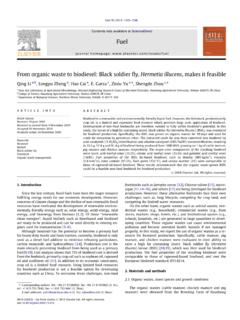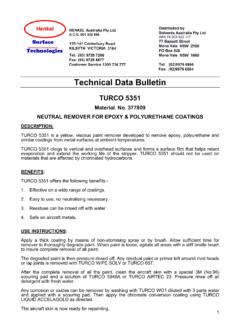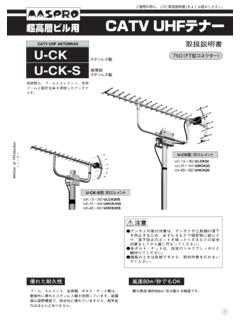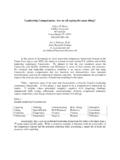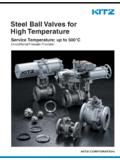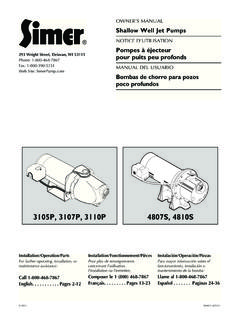Transcription of Molecular Analysis of Cellulose Biosynthesis in Tony ...
1 DOI: , 717 (1998);279 Science, et ArioliArabidopsisMolecular Analysis of Cellulose Biosynthesis in This copy is for your personal, non-commercial use only. clicking , clients, or customers by , you can order high-quality copies for yourIf you wish to distribute this article to others the guidelines can be obtained byPermission to republish or repurpose articles or portions of articles ): December 16, 2010 (this infomation is current as ofThe following resources related to this article are available online at of this article at: including high-resolution figures, can be found in the onlineUpdated information and services, #ref-list-1, 5 of which can be accessed free:cites 16 articlesThis article 332 article(s) on the ISI Web of Sciencecited by This article has been #related-urls100 articles hosted by HighWire Press.
2 See:cited by This article has been collections:This article appears in the following registered trademark of AAAS. is aScience1998 by the American Association for the Advancement of Science; all rights reserved. The title CopyrightAmerican Association for the Advancement of Science, 1200 New York Avenue NW, Washington, DC 20005. (print ISSN 0036-8075; online ISSN 1095-9203) is published weekly, except the last week in December, by theScience on December 16, from andS. pombe. Those results are consistentwith a model in which iron depletion ofnormal hepatocytes causes increased tran-scription of Cp that interacts with an irontransporter (also up-regulated by iron de-pletion), resulting in increased iron iron depletion requirement for Cp-stimulated Fe uptake, and the inhibitionby cycloheximide, are consistent with arequirement for an inducible iron trans-porter.
3 Taken together, the experimentsin yeast and hepatic cells demonstrate aremarkable evolutionary conservation ofthe mechanisms that underlie the pathwaycontrolling eukaryotic iron metabolism bycopper. However, there are noteworthydifferences: in yeast, the Cp homolog is amembrane protein that is co-transportedto the cell surface and is in continuouscontact with the iron transporter, whereasin mammalian tissues Cp is a secretedprotein, and any interaction with a trans-porter is likely to be transient. This differ-ence may be related to paracrine require-ments for Cp in multicellular AND NOTES_____1. B. R. Bacon, G. M. Brittenham, C. H. Park, A. ,Ann. Acad. , 155 (1988).2. R. S. Britton, A. S. Tavill, B. R. Bacon, inIron Metab-olism in Health & Disease, J.
4 H. Brock, J. W. Halliday,M. J. Pippard, L. W. Powell, Eds. (Saunders, Lon-don, 1994), pp. 311 J. H. Brock, inibid., pp. 353 R. D. Klausner, T. A. Rouault, J. B. Harford,Cell72,19 (1993).5. L. Ryde n, inCopper Proteins and Copper Enzymes,R. Lontie, Ed. (CRC Press, Boca Raton, FL, 1984),vol. III, pp. 37 E. B. Hart, H. Steenbock, J. Waddell, C. A. Elvehjem,J. Biol. , 797 (1928).7. H. A. Ragan, S. Nacht, G. R. Lee, C. R. Bishop, G. ,Am. J. , 1320 (1969).8. S. Osaki and D. A. Johnson,J. Biol. ,5757 (1969). , E. Frieden, , 2746 (1966). , , 3018 (1971).11. J. I. Logan, K. B. Harveyson, G. B. Wisdom, A. , G. P. R. Archbold,Q. J. , 663(1994).12. Z. L. Harriset al.,Proc. Natl. Acad. Sci. ,2539 (1995).13. H. Moritaet al.,Ann. , 646 (1995).14. D. S.
5 Yuanet al.,Proc. Natl. Acad. Sci. ,2632 (1995).15. J. Kaplan and T. V. O Halloran,Science271, 1510(1996).16. J. Kaplan,J. Clin. , 3 (1996).17. C. Askwithet al.,Cell76, 403 (1994).18. D. M. De Silva, C. C. Askwith, D. Eide, J. Kaplan,J. Biol. , 1098 (1995).19. C. Askwith and J. Kaplan, , 401 (1997 ).20. J. G. Parkes, E. W. Randell, N. F. Olivieri, D. ,Biochim. Biophys. Acta1243, 373(1995).21. H. P. Roeser, G. R. Lee, S. Nacht, G. E. Cartwright,J. Clin. , 2408 (1970).22. C. K. Mukhopadhyay, Z. K. Attieh, P. L. Fox, unpub-lished M. E. Bouma, E. Rogier, N. Verthier, C. LaBarre, ,In Vitro Cell. Dev. , 267 (1989).24. S. White, K. Miller, C. Hopkins, I. S. Trowbridge,Biochim. Biophys. Acta1136, 28 (1992).25. B. S. Stein and H. H. Sussman,J.
6 Biol. ,10319 (1986).26. R. Stearman, D. S. Yuan, Y. Yamaguchi-Iwai, R. , A. Dancis,Science271, 1552 (1996).27. B. B. Knowles, C. C. Howe, D. P. Aden, ,497 (1980).28. R. G. Batey, P. Lai Chung Fong, S. Shamir, S. Sher-lock,Dig. Dis. , 340 (1980).29. C. Hershko, G. Graham, G. W. Bates, E. A. Rach-milewitz,Br. J. , 255 (1978).30. For measurement of iron release, cells were pre-loaded with iron by incubation with 100mM55Fe-NTAfor 4 hours. The cells were washed with saline-EDTAand incubated with Cp for 30 min in RPMI medium;the amount of55Fe released into the conditioned me-dium was measured by liquid scintillation For measurement of iron uptake, cells were washedwith phosphate-buffered saline and then with iron-free RPMI medium. Cells were incubated with pu-rified human Cp (Calbiochem, San Diego, CA) inthe presence of and 1 mM ascor-bic acid in RPMI medium for 15 min at 25 C.
7 Thecultures were washed with saline-EDTA, and thecells were harvested with NaOH; after neutraliza-tion, cellular55Fe was measured by liquid scintilla-tion W. Breuer, S. Epsztejn, Z. I. Cabantchik,J. , 24209 (1995).33. Isolated nuclei from 53107 HepG2 cells were incu-bated with [a-32P]uridine triphosphate (100mCi,3000 mCi/mmol). The purified reaction productswere hybridized to linearized plasmid DNAs [Cp, 15mg of pcDNA3-Cp; vector control, 15mg of pcDNA3;and 1mg of pcDNA3 glyceraldehyde phosphate de-hydrogenase (GAPDH)] immobilized onto a We are grateful to J. Gitlin ( Washington University)for the full-length Cp cDNA and for helpful discus-sions. This work was supported by NIH grantsHL29582 and HL52692 ( ) and by a FellowshipAward from the American Heart Association, North-east Ohio Affiliate ( ).
8 26 August 1997; accepted 20 November 1997 Molecular Analysis of Cellulose BiosynthesisinArabidopsisTony Arioli, Liangcai Peng, Andreas S. Betzner, Joanne Burn,Werner Wittke, Werner Herth, Christine Camilleri,Herman Ho fte, Jacek Plazinski, Rosemary Birch, Ann Cork,Julie Glover, John Redmond, Richard E. Williamson* Cellulose , an abundant, crystalline polysaccharide, is central to plant morphogenesisand to many industries. Chemical and ultrastructural analyses together with map-basedcloning indicate that theRSW1locus ofArabidopsisencodes the catalytic subunit ofcellulose synthase. The cloned gene complements thersw1mutant whose temperature-sensitive allele is changed in one amino acid. The mutant allele causes a specificreduction in Cellulose synthesis, accumulation of noncrystallineb-1,4-glucan, disas-sembly of Cellulose synthase, and widespread morphological abnormalities.
9 Microfibrilcrystallization may require proper assembly of theRSW1gene product into synthasecomplexes whereas glucan Biosynthesis per se does , a crystallineb-1,4-glucan, is theworld s most abundant biopolymer. Its bio-mass makes it a global carbon sink andrenewable energy source, and its crystallin-ity provides mechanical properties centralto plant morphogenesis and the fiber indus-tries. The mechanisms that plants use insynthesis have not yielded to biochemistryor cloning by hybridization to genes encod-ing prokaryotic Cellulose synthases (1). Bycombining chemical and ultrastructuralanalyses with map-based cloning, we showthat theArabidopsis RSW1locus encodes aglycosyl transferase that complements thersw1mutant (2). The temperature-sensitiversw1allele disassembles Cellulose synthasecomplexes in the plasma membrane ( ro-settes ), alters Cellulose crystallinity, anddisrupts morphogenesis.
10 The gene product,which is closely related to the putative cel-lulose synthase catalytic subunit from cot-ton fibers (3), can therefore be used tomanipulate the production and physicalproperties of Cellulose , while the mutantlinks plant morphogenesis and impaired in Cellulose produc-tion were selected with the use of a radialswelling phenotype (rsw), which mimics re-sponses of wild-type roots to Cellulose syn-thesis inhibitors such as dichlorobenzoni-T. Arioli, J. Burn, R. Birch, J. Glover, Cooperative Re-search Centre for Plant Science, Australian NationalUniversity, Post Office Box 475, Canberra, ACT 2601, Peng, J. Plazinski, A. Cork, J. Redmond, R. E. William-son, Glycobiology Unit, Plant Cell Biology Group, andCooperative Research Centre for Plant Science, Re-search School of Biological Sciences, Australian NationalUniversity, Post Office Box 475, Canberra, ACT 2601, S.
